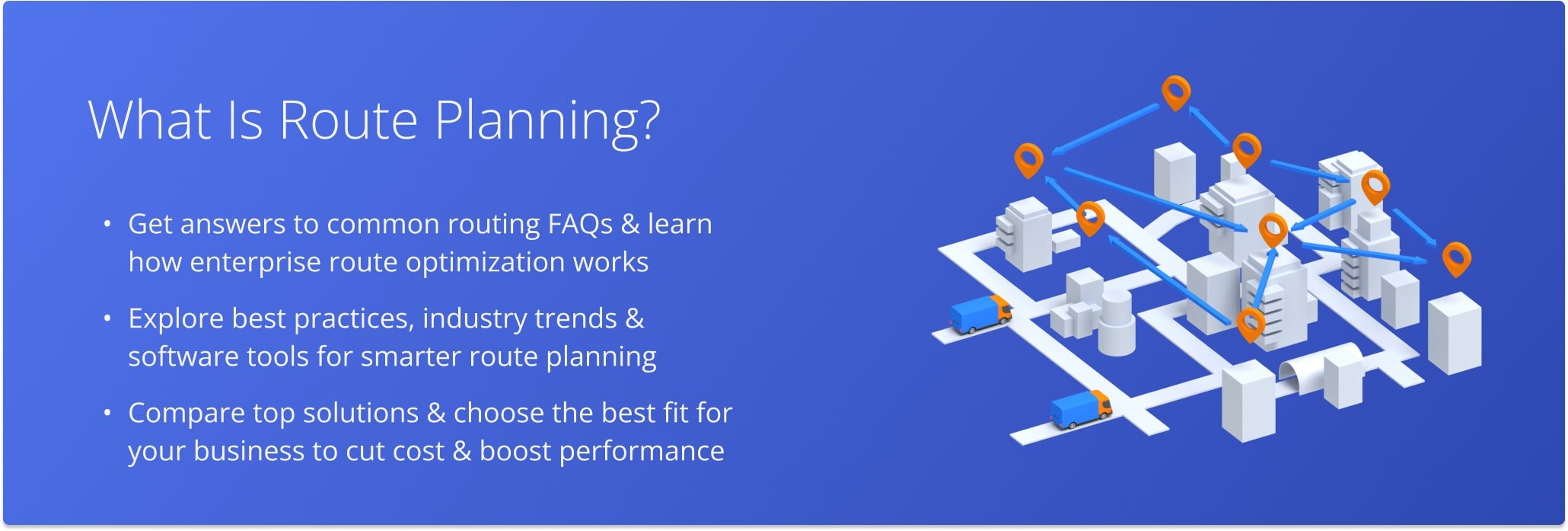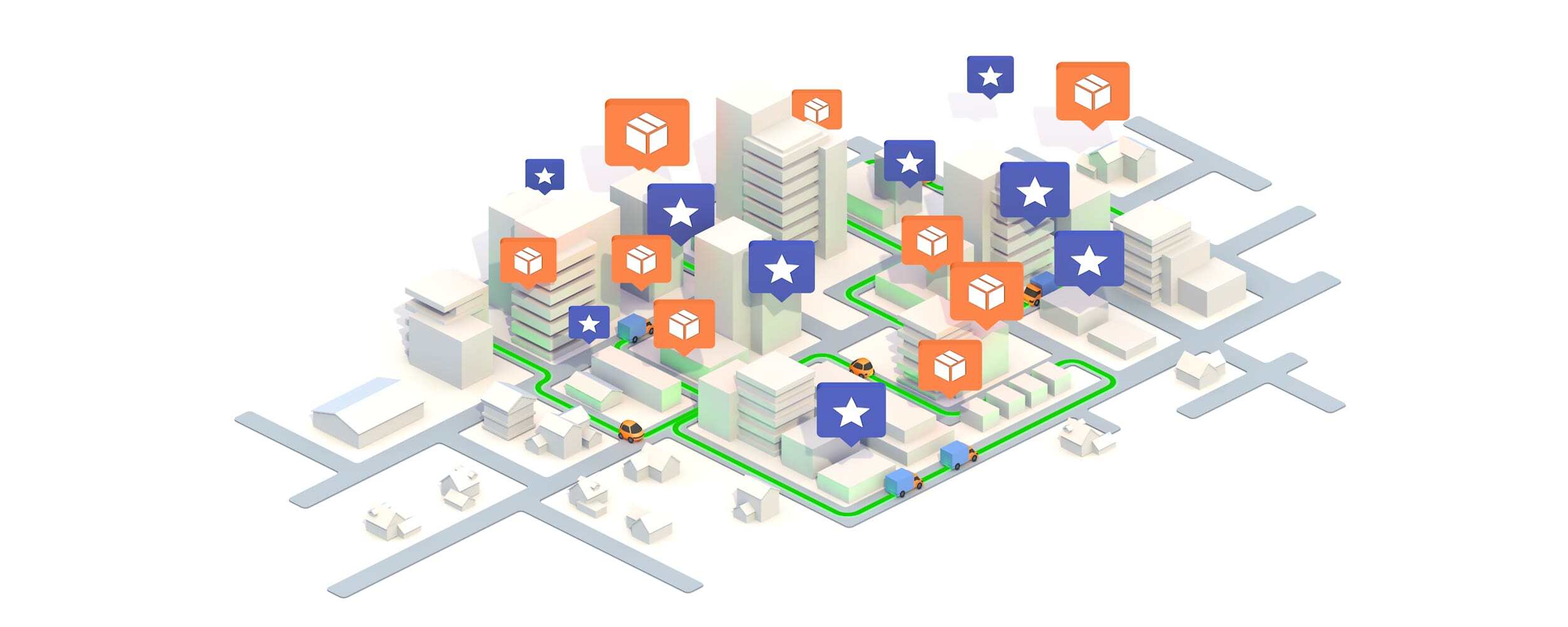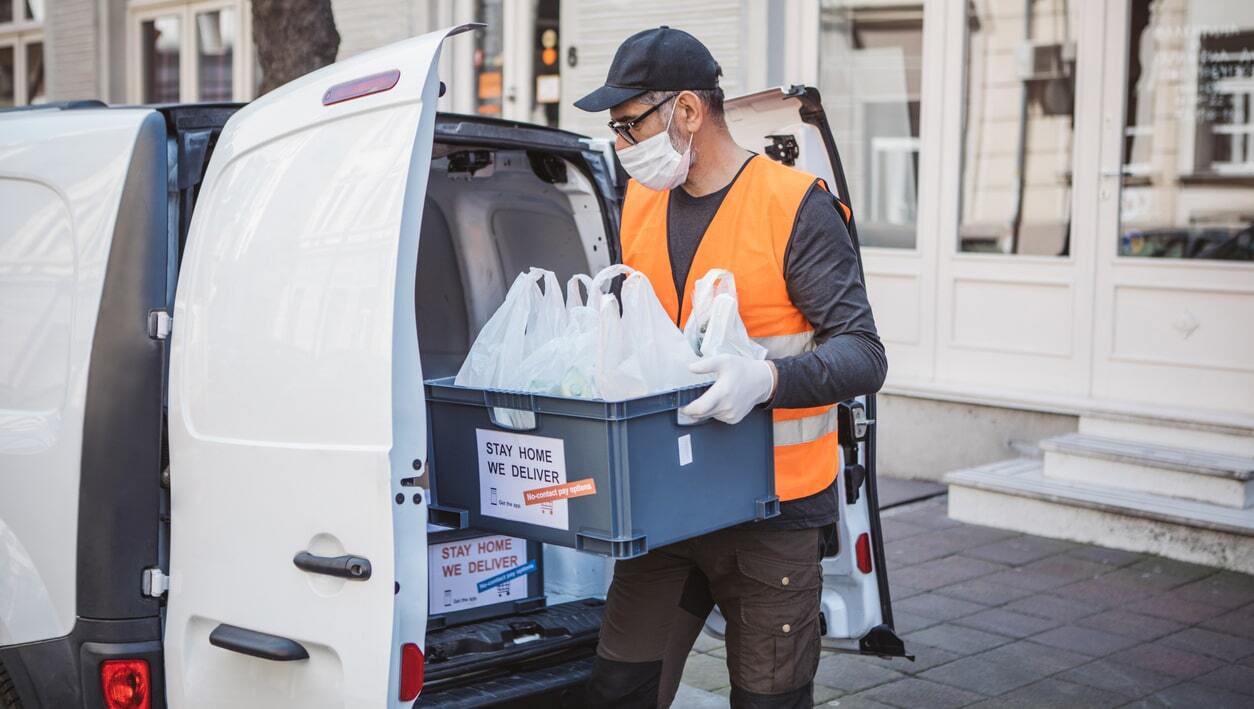What Is Route Planning in 2025? Trends and Best Software
Route planning is the secret behind last-mile efficiency and profitability. If you are running a last-mile business, you most likely need to map multiple locations and plan multi-stop routes. Independent courier services, food delivery, field sales, cleaning services, florists, catering, landscaping, maintenance, and many other last-mile businesses have to solve almost the same integral logistics problems: how to deliver more with less, make routes more profitable, increase customer satisfaction and loyalty, etc.
In this article, you will learn everything you need to know about route planning in 2025 and how your last-mile business can benefit from it. Here you can learn about routing best practices, route optimization software, routing in different industries, and more. Furthermore, this post will help you better understand your last-mile routing needs and choose the best route planning software for your particular routing requirements and unique business model.
Table of Contents
Route Planning Definition
The definition of route planning refers to the process of mapping multiple locations or addresses and visiting them in the most cost-efficient sequence possible. However, this is just the core of the route planning definition everyone agrees upon. That being said, depending on specific routing needs, industry, and the involved logistics processes, this definition can include thousands of business rules, customer variables, team and fleet constraints, etc. And this article aims to be an extensive guide on routing and explore all its dimensions while providing you with all the necessary information to win the last mile.
Frequently Asked Questions About Route Planning
Below, we’ve answered the most frequently asked questions (FAQs) about route planning, most of them submitted by Route4Me users, business owners, dispatchers, managers, and drivers. Whether you are looking for the fastest route optimizer or just want to learn about planning profitable routes, our FAQ section will provide all the answers and help you save time on researching the topic.
Route planning is the process of mapping multiple locations and sequencing multiple addresses in the most optimal order for delivering goods or making field service visits. Additionally, route mapping can entail route optimization, fleet management, route scheduling, route management, route tracking, driver management, and other components.
Furthermore, planning routes can include hundreds of business rules, customer variables, team and vehicle constraints, etc. For instance, with Route4Me’s enterprise route optimizer, you can plan routes that account for delivery windows, driver skills, vehicle loading capacity, and more! Moreover, the Route4Me dynamic routing software enables you to create pickup and delivery routes, service routes, field sales routes, maintenance routes, and many more.
Route planning consists of taking a set of locations or addresses and sequencing them in a specific order to create a route that you can navigate. Additionally, the best route planners allow you to produce a travel itinerary, driving directions, route instructions, mandatory driver tasks, etc. For example, Route4Me’s map route planner enables you to import hundreds of thousands of addresses, geocode and display them on the optimized map. Next, you can drag and drop addresses on the map and connect validated addresses in the preferred custom order to create routes. Additionally, our trip planner also enables you to schedule delivery routes, manage routes in real-time, and more.
The route planning problem is the process of figuring out the most optimal way to route multiple locations accounting for routing variables and constraints. Additionally, the routing problem is often associated with solving the Travelling Salesman Problem (TSP) and the Vehicle Routing Problem (VRP) – two logistics problems of utmost complexity. Equally important, this routing equation is often referred to as the route optimization problem. Accordingly, as the number of route stops increases, the difficulty of manually solving the routing problem goes beyond humans’ calculation capacity. Additionally, adding even a single customer variable or routing rule can add millions of possible routing scenarios. Such variables can include vehicle carrying capacity, customer time windows, fleet size, driver qualifications, and many more. Therefore, when creating a route with 10 stops, Route4Me’s proprietary route optimization algorithms compute through all possible routing scenarios to plan the best route possible.
The many route planning types can be split into two main categories: Dynamic Routing and Static or Recurring Routing. So, on the one hand, there is dynamic routing that enables professionals to plan new routes with different destinations every day. Moreover, the created dynamic routes can always be adjusted and re-routed in real-time. This gives logistics businesses the ability to adapt to any last-minute change instantly. On the other hand, there is recurring routing. This type of routing requires planning the same route with the same addresses with a specific daily, weekly, monthly, or yearly delivery schedule. Furthermore, under these two categories fall many other routing types or variations that can be customized depending on your business requirements and unique operating needs. For instance, with Route4Me’s routing software, you can use route planning by postcode, routing for truck drivers, delivery routing, pickup routing, or even route planning for electric vehicles. And the list goes on. Most route planning companies simply put whatever they are offering in front of or after this word combination (i.e., sales trip planning, local delivery routing, etc.).
Multi-stop route planning is the process of mapping multiple addresses or routing multiple locations to create a route. Basically, there is no difference between regular and multi-stop route planning. Therefore, multi-stop routing is based on the same rules and algorithms, involving multiple mathematical processes. Multi-stop route optimization is usually leveraged by last-mile carriers, field sales, field marketing, field service, and other field-oriented businesses. Further in this article, you can learn more about various online route planner tools and software for routing multiple locations.
Route planning is important for last mile businesses as it helps carriers and logistics-intense organizations to save money on fleet and logistics expenses while making money on more profitable service and delivery routes. Various business types and last mile carriers use it to make the most use out of their vehicles and drivers, make more deliveries or pickups in a single route, etc. Furthermore, properly optimized routes reduce driving time and mileage allowance, lower fuel expenses, and even raise customer satisfaction with on-time deliveries. Basically, the more organized and optimal your routes are, the more money you can make. For example, Route4Me’s patented routing technologies help last-mile businesses achieve a 300% increase in the efficiency of various routing and logistics activities without additional drivers, vehicles, or any other assets. This translates directly into only improving your supply chain and last-mile operation but also improving your bottom line.
The benefits of route planning enable last mile businesses to increase revenue and delivery profitability, raise fleet productivity and team performance, and even improve customer service. For example, with Route4Me’s route optimization software, you can get the following benefits:
The goal of logistics route planning is to optimize the last mile – the most expensive component of any supply chain. In fact, the last mile is the most expensive logistics operation as it accounts for 41% of the total supply chain costs. Thus, optimized routes in transportation and logistics intense environments enable any business that delivers goods or services to cut delivery costs for transporting goods to end customers. Moreover, the importance of route optimization in logistics is not limited only to cutting last mile expenses. Mainly, logistics professionals use routing software to optimize warehouse routes, plan efficient middle mile routes, automate reverse logistics planning, and more. Oftentimes, industry professionals look for the opportunity to manage and track their fleets and drivers from a single platform, such as Route4Me. With Route4Me’s route optimization software, businesses get an in-depth understanding of their entire logistics operation.
Route planning in sales is the process of mapping multiple customers and optimizing visitation routes for field sales representatives. The goal of sales route planning is to help field salespeople visit and sell to as many clients on one route as possible. To achieve this, field sales businesses often combine planning routes with route optimization and territory mapping. Sales territory management allows you to create optimal service areas and sales territories with customer addresses. Thus, you can evenly distribute the workload among the right sales reps with suitable professional expertise and skills. Then, you can use sales route optimization to automatically sequence customers’ addresses in the most time-effective visitation order. Therefore, it’s recommended that you use your customer relationship management service or system in combination with route planning for multiple stops software. For instance, Route4Me’s route optimizer software supports integration with Salesforce Sales Cloud. Thus, you can easily import Salesforce customers into the route planner, create sales territories, and plan sales routes with customer addresses.
Route planning software is a tool that helps logistics intense businesses map customer addresses and plan cost-efficient multi stop routes. In detail, route planner software computes the most optimal route with a set of locations and generates optimal driving directions or walking directions for visiting each address. Accordingly, as opposed to pen and paper routing or planning routes in Excel spreadsheets, routing software can plan routes fully automatically. For instance, with Route4Me’s route planning software, trip planners can plan routes for optimizing first mile, middle mile, and last mile logistics and routing operations with just a click of a button. Moreover, our route planning software also allows you to manage and organize routes, create delivery schedules, collect electronic proof of delivery, track logistics KPIs and delivery metrics, and much more.
Route planning software involves four main steps, including address import, location mapping, route creation and route mapping, as well as online or offline navigation. For example, with Route4Me’s routing solutions, you can effortlessly map a route by following these 4 easy steps:
The best route planning software should be able to account for an organization’s unique last-mile needs. And since every business has its particularities and individual logistics requirements, finding a route planning software solution to be a “one-size-fits-all” can be difficult. So, the ideal delivery software should feature multiple flexible tools to cater to the needs of different logistics intense and field-oriented industries. For example, Route4Me’s Route Planner offers advanced features for delivery, field sales, field marketing, field service, landscaping, pool cleaning, surveying, technicians, and virtually any business that needs to visit more than 10 addresses a day. Moreover, Route4Me’s route sequencing and optimization software helps over 32,000 small businesses and enterprises to win the last mile and has over 2 million downloads. This makes Route4Me the world’s most used route planning software in 2025. Read more about the most popular route optimization software solutions in 2025.
The route planning components include various planning, scheduling, management, and reporting activities that can vary depending on the specific organization. Being the most used route optimization software in the world, Route4Me has outlined the following components of the planning process for most last-mile businesses: Also, depending on your specific business type and routing needs, your process for planning and optimizing routes may include additional components.
Route4Me’s journey optimization apps enable you to automatically sequence hundreds of addresses and locations. Therefore, with a business driving route optimizer app, you can make scheduled service visits and deliveries faster and more cost-efficiently.
Route optimization is the process of automatically sequencing multiple addresses or locations in the most cost-efficient order. In addition to the number of addresses or locations, route optimization also uses various business routing rules and optimization constraints. For example, such rules and constraints can include fleet vehicle capacity, weather route conditions, weight restrictions, cargo cubic volume, vehicle types, etc. Optimizing millions of routes for thousands of last-mile businesses and organizations for well over a decade, Route4Me has refined the definition of route optimization. Thus, in addition to solving the Traveling Salesman Problem and the Vehicle Routing Problem, Route4Me’s route optimization software enables business owners, managers, dispatchers, and logistics professionals to solve routing scenarios with extra layers of complexity.
Route planning is the process of mapping multiple locations and manually sequencing them to create a route with optimal driving directions. In contrast, route optimization is the process of automatically sequencing mapped locations in the most optimal order. To sum up, planning routes is manual address sequencing, and optimizing routes is automated route sequencing for the shortest travel times and distances. Accordingly, Route4Me’s route mapping and planning software automatically maps addresses but also allows you to manually sequence route destinations. At the same time, route optimization software, such as Route4Me, enables you to input a set of rules and then automatically sequence destinations for the shortest driving directions and fast travel time between each destination. Thus, manually planned routes may have longer travel times and distances than routes automatically optimized with software.
Route Planning by Business Type and Industry
All last-mile business types and field-oriented industries that deliver products or services to customers can plan optimal routes to improve their bottom line and increase customer satisfaction. For instance, food delivery, retail stores, meal delivery, online stores, small couriers, installation and maintenance, healthcare and pharmaceutical, pest control, waste collection, laundry and cleaning, catering, field sales, e-commerce, and many more.
Small Businesses Route Optimization
Additionally, all business sizes can benefit from using use routing tools for their unique needs. For instance, small businesses don’t have the same resources like Amazon or UPS. But they can still optimize their routes without breaking the bank using affordable routing software.
Medium-Sized Businesses Logistics Optimization
Similarly, medium-sized businesses can use route optimization tools to make more deliveries and visit more customers without any additional vehicles and drivers. Basically, planning Amazon routes and providing UPS shipping without the Amazon and UPS costs. Moreover, with the best route optimizer apps, medium-sized enterprises can easily provide Amazon delivery and UPS delivery quality without the same high costs.
Enterprises Last Mile Planning
Finally, route making for enterprises enables companies to save thousands – if not millions – of dollars. How? By cutting fuel expenses, minimizing accident risks, lowering CO2 emissions, and more. Additionally, enterprise-grade software also supports such features as route reporting dashboards, customer notification services, real-time driver tracking, planned vs actual route metrics, driver performance monitoring, etc.
Furthermore, your route optimization app should also support integrations with third-party systems. For example, your can easily integrate Route4Me’s enterprise-grade route planner with:
- Vehicle maintenance software
- Purchasing and accounting software
- Fulfillment services
- Workload management apps, etc.
Additionally, you can easily integrate with various customer relations management (CRM) tools, such as HubSpot, Zoho CRM, Pipedrive, etc. Or, e-commerce platforms like Shopify, Magento, WooCommerce, and other online stores.
Last Mile Trends in 2025
The COVID 19 pandemic forced many brick and mortar shops to close physical venues and open online stores, changing their business model fundamentally. Moreover, restaurants, bars, and other similar establishments had to switch to curbside pickup, delivery, takeout services, or other servicing methods that minimized social interaction. All this introduced one more step before the usually store-bought product reached the end customer: last mile delivery.
The average consumer was suddenly heavily reliant on delivery for the most basic needs. Therefore, contactless delivery, curbside pickup, and the people making these possible were the true heroes of the pandemic, helping people purchase products without exposing themselves to the highly contagious virus. In fact, this was the time when many consumers made their first online purchase.
Combined with more and more people getting comfortable with online shopping and with businesses turning to a digital-first approach, the pandemic accelerated eCommerce adoption globally. This resulted in a surge in demand not only for e-retailers and eCommerce delivery businesses but also for last mile carriers that had to find ways to deliver more with less overnight. On the other side of the fence, businesses that kept delivery in-house had to swiftly figure out how to deliver as fast and as cheap as possible just to stay afloat.
In the post-COVID world, consumer behavior might not change back. This means there’s a high chance that customers worldwide would still order most of the items on their shopping lists online. As a result, route planning and route optimization have become vital to delivery-based businesses and order-at-home customers alike. Well optimized routes translate into more orders fulfilled, faster deliveries, and happy customers.
Learn about last mile optimization in the post-COVID-19 world in our Free Last-Mile Delivery eBook.
The Best Route Planning Software 2025
Finding the best route planning software in 2025 can be tricky. Whether you are an individual contractor or driver or you are running a last-mile business, your route optimization software must be able to accommodate your unique logistics and routing needs.
Route4Me Last Mile Optimization Software and Route Planner App
The Route4Me Route Planner is the world’s most used route sequencing and optimization software for small businesses and enterprises. Furthermore, Route4Me provides a continuous process from routing and scheduling all the way to route dispatch and real-time navigation. With over 32,000 customers, Route4Me is used by businesses across industries such as:
- Retail, e-retail, and eCommerce
- Field service, field sales, field marketing, and field merchandising
- Last mile carriers and local delivery businesses
- And many other businesses that require last-mile optimization
Overall, Route4Me helps businesses achieve a 300% increase in the cost-effectiveness of most routing and logistics activities without additional investments. Namely, businesses using Route4Me can grow without adding more drivers, vehicles, or any other expensive assets. And Route4Me’s modular approach to custom routing solutions enables to accommodate all types of last-mile companies. Additionally, you can read more about Route4Me route planner reviews on the Capterra top route planning software reviews website, G2 software reviews, Software Advice business route planning SaaS reviews, and other similar platforms.
Route Planning Free Software Trial
So, is there a route planner that can route for me for free?
Yes, Route4Me offers new users a Free Route Planning Software Trial for 7 days. That means a week of free of charge, automated route planning.
Can I use my real business data to plan my route for free and check out the benefits?
Yes, Route4Me’s free routing software trial offers you the chance to experiment with your own customer data base. With Route4Me, you can create fast and profitable routes customized for your unique business needs. Moreover, you don’t need to input your credit card details when signing up for the free route planner trial.
Sounds Great! Show me How to Map My Route for Free right now!
All the trademarks, logos, and brand names on this page are for identification purposes only. We do not endorse these trademarks, logos, and brand names. All the trademarks, logos, and brand names are the property of their respective owners. If any of the trademarks, logos, and brand names are your property or the property of your company, and you would like us to remove them from our website, please contact us at [email protected] to submit your request.
Visit Route4Me's Marketplace to Check out Associated Modules:
- Routing Business Rules
Business Rule - Max Stops Per Route
- Operations
Advanced Team Management Add-On
- Operations
Audit Logging and Activity Stream
Last Updated:





